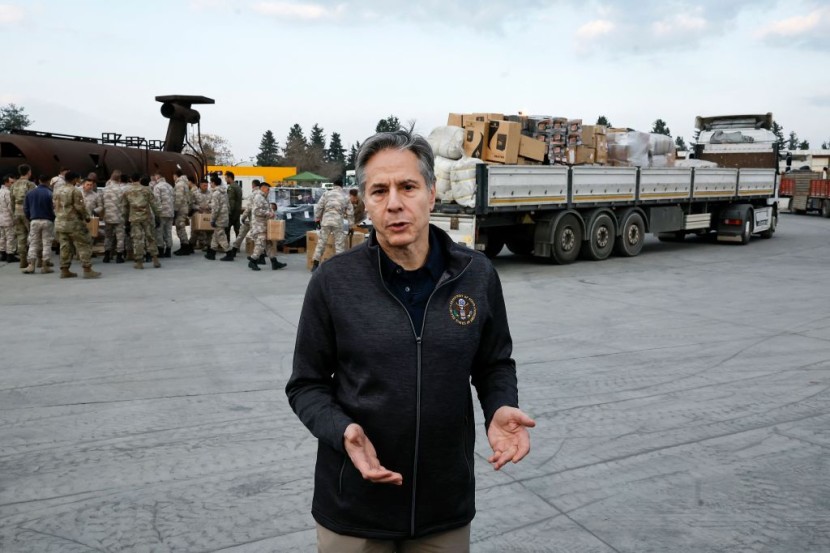
US Secretary of State Antony Blinken offered more aid to Turkey and stated that the United States would provide long-term assistance to Ankara as it attempts to recover following the earthquake earlier this month.
On February 6, a 7.8-magnitude earthquake rocked the southeast of Turkey and neighboring Syria, killing more than 45,000 people and displacing more than a million more. The tragedy is likely to cost billions of dollars.
US Aid to Turkey, Syria
Blinken came to Incirlik Air Force Base on Sunday for a formal visit and to explore how the United States government may provide more assistance, according to Reuters. From Incirlik, he took a helicopter trip with Turkish Foreign Minister Mevlut Cavusoglu to witness the earthquake's damage in the southern province of Hatay, one of the most impacted, from above.
On the trip, reporters witnessed the uneven devastation caused by the big earthquake, with some buildings still intact but with fallen roofs and damaged windows. Several residential structures leaned strongly to one side when lower floors fell, and blue and white tents were erected up among the wreckage to house survivors.
Over two weeks after the earthquake, search and rescue activities are winding down, but Blinken stated that the United States will continue to assist in what he termed a "long-term endeavor."
According to the agency head, the search will continue in Kahramanmaras and Hatay. Yet, the likelihood of finding anyone else alive in the wreckage rapidly diminishes. It is confirmed that around 44,000 people have perished in southeastern Turkey and northern Syria.
The death toll is anticipated to rise since around 345,000 apartments throughout Turkey have been damaged and many individuals remain unaccounted for. BBC reported that neither Turkey nor Syria has indicated how many individuals remain unaccounted for.
"In many of our regions, search and rescue operations have been concluded," Yunus Sezer, the head of Turkey's disaster service, told reporters in Ankara. He said that search and rescue operations were ongoing at around 40 structures in the two provinces, although he anticipated that this number would decrease by Sunday evening.
Turkey-Syria Earthquake Rescue
At least three individuals were rescued from the rubble on Friday, more than 11 days after the earthquake buried them. Even though the trip was scheduled before the earthquake, Blinken arrived in Turkey to express solidarity. Since assuming office almost two years ago, this is his first visit to Turkey.
Prior to his meeting with President Recep Tayyip Erdogan on Monday, he will visit Hatay to see humanitarian activities. Issues such as Turkey's unwillingness to ratify Sweden and Finland's NATO membership bids are anticipated to be discussed.
The United Nations has stated that it may take months to discover the exact extent of the casualties. Blinken is on his first trip to NATO partner Turkey since assuming office two years ago, as per Daily Mail.
He will visit a tent city in Hatay for people affected by the earthquake, followed by a visit to an aid distribution center. In addition, the top US diplomat will assess US humanitarian operations and interact with members of USAID's Disaster Assistance Response Team, who are experts in rapid response to disasters.
Over 105,794 structures inspected by the Environment and Urbanisation Ministry of Turkey are either demolished or severely damaged, the ministry announced today. The damaged or destroyed structures housed more than 384,500 residential units, primarily flats.
Many structures in Turkey must be reinforced and erected under stringent construction requirements due to the country's many fault lines, as mandated by infrastructure legislation.
In the fourteen years following the 1999 earthquake, more than $1 billion has been invested in upgrading buildings to guarantee they meet the criteria. Nevertheless, most of this expenditure has occurred in Istanbul and Ankara, the two largest cities in the north.
In the southern provinces devastated by last week's earthquakes, however, a lack of oversight - and a policy loophole that allows builders and developers found to have fallen short of standards to pay fines rather than be forced to improve their buildings - means that thousands of people likely perished as a result of substandard building practices.
Eyup Muhcu, head of the Chamber of Architects of Turkey, stated that it was "common knowledge" that many structures, even new flats constructed after the implementation of earthquake-resistant construction rules, were substandard.
Muhcu told the Associated Press that the Turkish government has effectively legalized hazardous structures by allowing developers to pay penalties instead of redoing substandard work. In the days following the original earthquake, Turkey's disaster administration reported that 6,040 aftershocks struck the 11 provinces that make up the disaster zone proclaimed by the government.
The original earthquake had a magnitude of 7.8 and was followed by a 7.5-magnitude tremor nine hours later. Orhan Tatar, general manager of the AFAD agency, claimed 40 aftershocks were of a 5 to 6 magnitude, while one was registered at 6.6. Moreover, he warned of "secondary calamities" such as mudslides and rockfalls.
Related Article : Turkey-Syria Earthquake: USA Sending $85 Million Aid
@YouTube
© 2025 HNGN, All rights reserved. Do not reproduce without permission.








